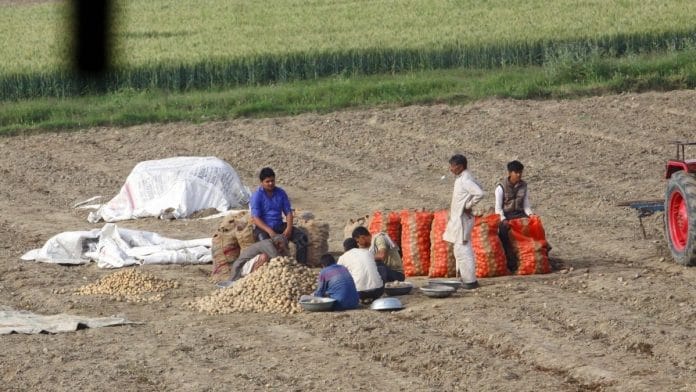Last fortnight, the Government of West Bengal invoked the draconian Essential Commodities Act to curb the movement of potatoes—Solanum Tuberosum—to the neighbouring states of Odisha, Assam, and Jharkhand. This decision came as the tuber started retailing at Rs 40–45 per kg in Kolkata—double the price of last November—giving the government an alibi to impose restrictions on its storage, trade, and transport.
In the past, however, the government had adopted alternative but equally effective measures, such as deploying the state agriculture marketing department through its SAFAL outlets and consumer cooperatives to cut intermediation costs to zero, making the produce available to consumers at wholesale rates. Trade sources suggest there is sufficient stock in West Bengal’s cold storages to meet the state’s requirements until the onset of fresh arrivals.
To most observers, this populist measure, which pits consumers in Kolkata against those in Guwahati, Ranchi, and Bhubaneswar, can only have long-term negative implications for farmers, cold chain and logistics operators, and traders in West Bengal, as it will deter fresh investments in one of the state’s key growth drivers.
The potato’s journey in India
Before delving into the specifics of this commodity’s current crisis, let’s take a moment to understand how this Peruvian tuber—known as Aloo, Batata, Uralaikilangu, Kook, Alu, and Urulakizhangu across India—became one of the country’s most ubiquitous horticultural products. Introduced by Portuguese and Dutch traders along the Malabar Coast, the potato gained momentum under the British East India Company in the 18th century. However, the British push wasn’t entirely noble; it was part of their “civilising” mission to replace local vegetables with what they considered superior plants.
By the 19th century, potatoes were grown extensively across Bengal—which then included large parts of Assam, Odisha, and Bihar—and in the hills of North India. After Independence, potato cultivation took off significantly. From a production of 1.5 million metric tonnes (MT) in 1948–49, it soared to 60 MT in 2023–24. By comparison, rice production during the same period grew fivefold, from 21 MT to 100 MT, while wheat increased roughly 15 times, from 7.5 MT to 113 MT.
Although this year’s potato production may fall slightly below last year’s record, the drop is unlikely to exceed 1–1.5%. Nonetheless, even a marginal dip in production has significantly impacted prices due to market dynamics and the “perception factor.”
Also read: UP potato farmers’ problem of plenty — a bumper crop but limited places to sell, store
The 12-week Rabi crop
The potato is a 12-to-14-week Rabi crop, typically planted at the onset of winter in November and harvested by late January or early February. While production is concentrated in this narrow window, consumer demand spans the entire year. The two leading potato-producing states—Uttar Pradesh (16–16.5 MT) and West Bengal (12–12.5 MT)—together account for nearly half of India’s production. A significant portion is stored in one of India’s 8,653 cold storages, with Uttar Pradesh leading in capacity, followed by West Bengal.
Although Bihar produces 9 MT, its limited cold chain infrastructure means its potatoes are marketed first, both in the eastern region and NCR. From April onward, potato prices rise monthly due to cold storage rental and electricity costs. Offtake peaks during the October–November festival season, and prices in the final weeks hinge on remaining cold storage stocks.
This year’s sharp price hike stems from delays in last year’s sowing season and high temperatures during the end of the Rabi season, which affected harvests. The resulting shortage of about 1 MT—a 1.5–2% decline—has caused disproportionately large fluctuations in consumer prices.
The many flavours of potato
The Condé Nast Traveller once described the potato as a “chameleon”—a versatile ingredient that absorbs the flavours of any dish. It seamlessly fits into every meal of the day, from Punjab’s aloo parathas and Awadh’s puris with tangy potato curry to Madras’s masala dosa and potato wedges served alongside omelettes or used in vegetable cutlets on IRCTC menus.
For lunch and dinner, the variety is even greater: Bihari aloo chokha (mashed potatoes with green chilies and onions), Kashmiri dum aloo (spicy yogurt-based curry), Bengali aloo posto (potatoes in poppy seed paste), and Manipuri eromba (mashed potatoes with bamboo shoots and dried fish). There’s also Kerala’s spicy potato roast, Maharashtra’s aromatic batatyachi bhaji, and Kolkata Biryani, where potatoes—infused with the flavours of meat and spices—play a starring role.
Potato’s role in policy, global platforms
Potatoes are also at the centre of a jurisdictional tussle between state agriculture and horticulture departments and between the Agriculture and Horticulture Commissioners of India. This struggle determines who controls research, extension services, and representation at regional and global potato conferences.
This year, the World Potato Congress was held in Adelaide, Australia, while the 2025 and 2026 editions are scheduled for Orlando, Florida (USA), and Gdansk, Poland.
Indeed, this humble tuber has the power to take you places!
Sanjeev Chopra is a former IAS officer and Festival Director of Valley of Words. Until recently, he was director, Lal Bahadur Shastri National Academy of Administration. He tweets @ChopraSanjeev. Views are personal.
(Edited by Prashant)






